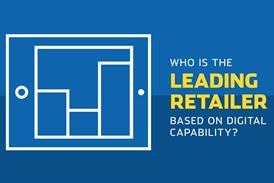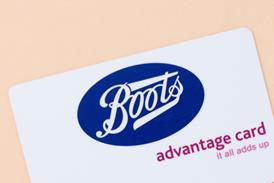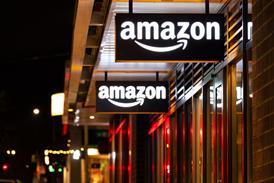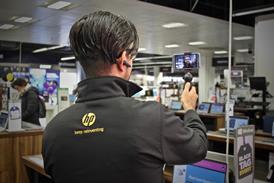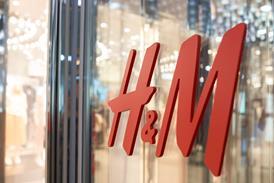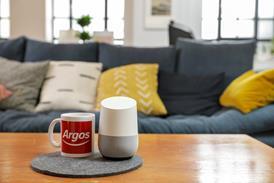- Rankings
- Marketing
- Logistics & customer service
- Cross-channel
- Ecommerce
 Evri reports 30% increase in US parcel deliveries as postal firms pause shipments
Evri reports 30% increase in US parcel deliveries as postal firms pause shipments Q&A: New boss of H&M-backed Centra Sara Laurell wants to keep the growth coming
Q&A: New boss of H&M-backed Centra Sara Laurell wants to keep the growth coming Why retail is lagging behind other sectors in AI investment
Why retail is lagging behind other sectors in AI investment Q&A: Currys Business’ Dean Kramer on growing brand awareness to reach more UK firms
Q&A: Currys Business’ Dean Kramer on growing brand awareness to reach more UK firms
- Case studies
- Methodology
Cross-channel
We assessed how well connected retailers are across their online and offline channels to understand how they are bridging the divide, as well as how effective their efforts are in driving customers to stores.
The relevance of shops has come under the spotlight, with footfall declining and store closures becoming the norm.
But with online sales growth slowing, many retailers are investing to connect their online and offline channels to create a frictionless shopping journey, to eliminate any barriers to purchase.
Top 12 leading retailers in the cross-channel category
| Rank | Retailer | % |
|---|---|---|
| 1 | Apple | 77.4 |
| 2 | Marks & Spencer | 76.1 |
| 3 | Boots | 70.6 |
| 4 | Topshop | 70.3 |
| 5 | House of Fraser | 69.4 |
| 6 | Argos | 63.3 |
| 7 | John Lewis | 57.8 |
| 8 | Burberry | 57.5 |
| 9 | Zara | 56.9 |
| 10 | Go Outdoors | 56.6 |
| 11 | Schuh | 56.0 |
| 12 | JD Sports | 55.0 |
Encourage cross-channel behaviour
Click and collect has gradually become engrained in customers’ shopping habits, providing convenience for shoppers and an opportunity for retailers to drive additional purchases in-store.
The importance of click and collect has seen John Lewis invest in new store formats where collection points are positioned at the heart of the store, as well as opening a ‘Click and Commute’ shop at London’s St Pancras station.
Despite being regarded as fundamental for any multichannel retailer, 18% of multichannel retailers still don’t offer click and collect in store.
Retailers are, however, also opting for third-party collection points, with 29% of retailers offering this through the likes of Hermes and Collect+. Third-party collection and returns are vital for retailers with limited or non-existent store networks to build a physical presence.
This has seen the likes of luxury etailer Farfetch partner with Doddle collection points as part of its aim to create a “360 degree shopping experience”, while Asos and Missguided have partnered with Asda’s Toyou collection points.
Be channel agnostic
With stores standing as one of the biggest costs to retailers, customers are also being encouraged to research online and purchase offline to drive store profitability.
One digital initiative to drive footfall to stores is offering store stock visibility online. However, only 26% of retailers have implemented this strategy, made possible through developing a single view of stock.
Screwfix is a prime example of this. While founded as a mail-order operation, the DIY specialist has since developed a store network underpinned by store stock visibility in local shops. The retailer partnered with Oracle to gain a single view of stock across the business, allowing customers to check availability in stores and collect within 60 seconds.
The likes of Argos and Schuh have taken this one step further, enabling customers to reserve online and pay in-store.
With this, retailers would benefit from implementing geo-location on their sites to create a more seamless experience for customers on the go. With online traffic migrating heavily towards mobile, it’s surprising that only half of retailers offer geo-location on mobile devices.
However, physical space brings restrictions in the volume of products made available in store. As such, nearly a quarter of retailers offer a holistic view of the range in-store through self-serve digital screens, while 19% have armed employees with transactional tablets, making it possible for customers to order in-store, and have products delivered to a convenient location.
Importance of customer data
Just as important as digital screens and in-store tablets – if not more so – is enabling shoppers to browse with ease on their own devices. However, only 36% of retailers provide Wi-Fi in store.
For those that make the process easy, there is a great prize: the collection of customer data.
One in 10 retailers are using beacons to detect a customer’s location when they enter a store, offering retailers access to their personal details and the opportunity to personalise the experience through communications.
While costly, strong digital networks allow retailers to invest in innovative customer facing capabilities, such as augmented reality, which can further personalise in-store experiences. Bathstore, for example, has developed its viewAR tablets to enable shoppers to virtually enter, walk around and explore bathroom designs.
Cross-device shopping is also underpinned by customer data. Over 80% of retailers enable cross-device shopping so customers can browse on the desktop and continue their journey straight on to mobile, making it an essential practice.
While retailers are inundated with customer data across the online channel, the accumulation of data across the store network is still limited. As such, retailers’ digital strategies should be focused on understanding the role that its digital channel plays in driving footfall to stores. Stores must evolve with a digital backbone to complement cross-channel shopping habits, and new technologies should support, rather than replace, staff interaction.
CASE STUDY
Apple reimagined bricks-and-mortar retail
When it comes to cross-channel capabilities, Apple has raised the bar. It offers customers a seamless experience, however they choose to shop, but is renowned for its in-store prowess.
Apple founder Steve Jobs – particular and prescriptive about how his brand should be presented – threw out the rule book and entirely reimagined bricks-and-mortar retail.

His experiential stores, with no tills and high numbers of store staff, put traditional retailers in the shade and has since driven consumer expectations upwards.
Data compiled by Retail Week Prospect last year showed Apple generates the highest level of sales densities in the UK, with sales per square foot of £3,250, around 40% higher than the number two retailer, Burberry.
As a technology brand with a relatively low SKU count, Apple does not face the same challenges as a fashion or grocery retailer might. But, compared to its peers – the in-store experience offered by Maplin or Curry’s PC World, for example – the difference is markedly clear.
Apple stores are a destination, and not just because of their impressive architecture or highly desirable locations. They are more than showrooms, they are ‘do rooms’, with the focus being firmly on using the products.
The store is strewn with products for shoppers to interact with, test and explore. The minimalist interiors, with lots of clear floor space and clean lines, reflects the nature of the products on sale.
Unified store and online teams
Service sets the stores apart too. Only loyal Apple-lovers are hired. Staff are scrupulously screened and trained before being allowed on the shopfloor to interact with customers.
And there’s no divide between store teams and online teams because the stores are the definition of digital-first. The two businesses are operated as a single unit to create and facilitate a truly seamless shopping experience.
Not a till or queue in sight – store staff assist customers using tablets and payment is taken through customers’ Apple accounts, much like purchasing online. Apple can then harness the customer data it acquires to tailor its communications or upsell.
Shoppers can also book appointments online before visiting the store to speak to an adviser (known as a ‘genius’) about a specific issue. This appeals to the time-poor shopper against the idea of queuing and allows Apple to flaunt its service credentials.
To prevent a wasted trip, shoppers can view in-store stock availability on the app, mobile site and desktop site before they visit. This also encourages
customers to pop into a store to pick up what they need, rather than simply purchasing online.
Apple provides a joined-up shopping journey across all devices. If customers start shopping on their mobile, for example, the items they have put in their basket will also be visible on the app or on desktop, and even visible for store staff to see.
For those that do just want to complete the journey online, Apple also offers the full repertoire of cross-channel delivery options, including click and collect to one of its stores, and collection or return through a array of third parties.



